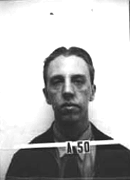Lester Skaggs (1911-2009) was an American physicist.
Skaggs was born in Missouri, where he grew up on a farm. He earned a B.S. in chemistry and an M.S. in physics from the University of Missouri. Skaggs also earned a Ph.D. in nuclear physics from the University of Chicago.
After the outbreak of World War II, Skaggs was drafted to serve in the U.S. Army. He was first assigned to the Department of Terrestrial Magnetism at the Carnegie Institute in Washington, D.C., where he helped to develop a system of radio waves which could detect enemy planes and ships. Two years later Skaggs was sent to Los Alamos to work on the Manhattan Project. Among his assignments was the development of a delayed detonation mechanism for the Fat Man plutonium implosion bomb dropped on Hiroshima, giving the drop plane enough time to fly a safe distance away from the blast.
As Skaggs’ daughter Margaret later remembered, “He thought the decision to use the bomb was a correct one. Then, after the war was over, I think he was very happy to find other uses for nuclear energy. He was a scientist. It wasn’t an easy decision. They were racing to get these things done. They weren’t even sure they would work or if they would have another one.”
After the war, Skaggs went to the University of Illinois to study the medical uses of radiation, and would become a pioneer in the field. In 1948, he became a professor at the University of Chicago, where he would teach for almost 50 years. He was soon made the head of the radiation therapy program at the nearby Argonne Cancer Research Hospital. Skaggs also launched the University of Chicago’s master’s program in medical physics, the first of its kind in the United States. Skaggs later spent five years at the King Faisal Specialist Hospital and Research Center in Riyadh, Saudi Arabia, where he helped to develop a radiation treatment program.
Lester Skaggs died on April 3, 2009, in Chicago.





